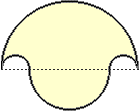Subject: "Le salinon d'Archimèdre"
I am trying to find the English translation of "Le salinon d'Archimèdre" and would appreciate any help. This is a figure, presumably studied by Archimedes, created from 4 semi-circles. Since I can't draw it for you, I will try to describe it with the help of the 5 collinear, horizontal points below.
. . . . . A B C D E
A semi-circle is constructed on AE as diameter (let's say above AE).
Two more semi-circles are then constructed with diameters AB and DE on the same side of the line AE as the first semi-circle (above it). Finally, a fourth semi-circle is constructed on diameter BD, this time on the opposite side of the line AE from the others (i.e. below the line).
These semi-circles and the region enclosed by them constitute what is called in French "Le salinon d'Archimèdre".
If you know the English name of this curve I would appreciate it if you let me know.
Don
This is a facinating question. The short answer is that in English we call this figure the Salinon of Archimedes. The explaination is in The Works of Archimedes, Edited in Modern Notation, by T.L. Heath, Dover 1953. The original works of Archimedes were lost but in a footnote on page xxxiii Heath refers to the Greek word salinon (salinon probably 'salt-cellar') as follows.
"The best authorities appear to hold that in any case the name salinon was not applied to the figure in question by Archimedes himself but by some later writer. Subject to this remark, I believe salinon is simply a Graecised form of the Latin word salinum. We know that a salt-cellar was an essential part of the domestic apparatus in Italy from the early days of the Roman Republic."
Other suggestions have been given for the meaning of this word but Heath continues.
"Moreover the explaination of salinon as salinum has two obvious advantages in that (1) it does not require an alteration of the word, and (2) the resemblance of the lower curve to an ordinary type of salt-cellar is evident."
Harley
